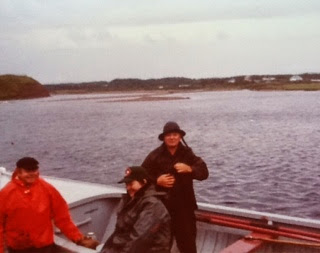The food fishery started in Newfoundland this week. There are stories of large fish this year and fishers delighted with fish for the freezer to enjoy for the rest of the year.
When codfish were plentiful, Newfoundlanders didn't take the the bounty of the sea for granted however. They used as many parts of the fish as they could. Besides the fillets, the cheeks, britches (roe), chitterlings (milt), heads and tongues were all used for food. Livers were a source of cod liver oil.
Melvin Smith, Shirley and Newman
A cod tongue, actually a small muscle from the neck of the fish, is really considered a treat. The tongues are meaty morsels, the size of which depends on the size of the fish. Besides the meaty bit, there is also a jellied part as well. Some people cut off the jellied bit but most people leave it on the tongue.
Lunch aboard Newman's boat
The cod tongues can be baked, or fried and a few rare people, like my father, like them poached. The most common way to cook them, however, is fried in fat pork. You fry out salt pork, then the tongues, lightly seasoned and floured, are fried in the fat. It is a unique dish and not as common today because of the unavailability of fresh whole cod, except for the fish caught during the short food fishery every year.
When Melvin and Sylvia fished with their friends Newman and Shirley at Robinson's on the west coast of Newfoundland, they always cut out the cod tongues, an important part of the catch. They loved the tongues, as evidenced by the looks on their faces leaning over that bucket. Each of them looked forward to those meals all winter long.
Yummy!
Today is Newman's birthday. Have a great day, Newman. Hope it's your best birthday ever. Enjoy!







No comments:
Post a Comment